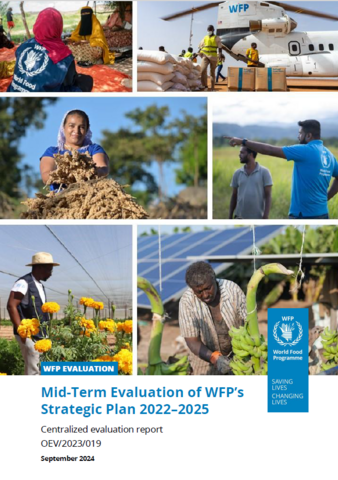
The mid-term evaluation of the WFP Strategic Plan (2022-2025) covered the first two years of its implementation. It focused on assessing its relevance and utility to strategically steer the organization, as well as the extent to which WFP is institutionally equipped to deliver on the plan’s ambitions.
The key objective of the evaluation was to inform management decisions on implementation and future programming. In particular, it was timed to inform the design of the next strategic plan that will be presented to the WFP Executive Board for approval in June 2025.
Key findings:
- Relevance and strategic focus: The evaluation found that the Strategic Plan was well aligned with the SDGs and with other relevant normative frameworks including those related to strengthening of the United Nations system. Building on its predecessor (2017-2021), the plan introduced some important shifts, such as greater integration of the Changing Lives and Saving Lives agenda, adopting an incremental rather than step-change approach that allowed for continuity and consolidation of ongoing initiatives.
The Strategic Plan helped clarify WFP’s ambitions in the Saving Lives and Changing Lives agenda, but was less helpful for prioritizing interventions at the country level, inadvertently encouraging proliferation of activities with limited internal coherence. This gap in strategic direction increased the risk of stretching WFP too thinly and rendering the organisation more reactive to funding opportunities than being strategically driven. - Policy architecture and guidance to support implementation: WFP policy framework and related guidance are aligned to the Strategic Plan and largely provide the tools to implement it through Country Strategic Plans, but they have not helped clarify organizational priorities. The volume and complexity of current policies, strategies and guidance are difficult for users (especially country offices) to absorb. There is a demand for simplified, consolidated and more practical guidance. There are signs that this is being recognised in more recent policy formulation.
- Evidence-based integrated programming: There has been progress towards more integrated programme design but insufficient organizational support to operationalizing integration on the ground. There is tension between integration efforts and WFP’s budget structure, line of sight requirements and corresponding management structure. Under the Strategic Plan there has been growing emphasis on the use of evidence for accountability and learning. Resources for gathering evidence have, however, been heavily weighted towards monitoring for ostensibly aggregable reporting based on corporate requirements that have become increasingly cumbersome. However, knowledge management remains a weakness, with evidence insufficiently linked to decision-making, including for scaling up innovations.
- Institutional mechanisms supporting implementation: The implementation of the Strategic Plan has been supported by several mechanisms and processes aiming to improve WFP ability to do the right thing at the right time, but the agility of the budget revision process remains a challenge. Complementarity in the division of labour between headquarters and regional bureaux to support country offices for programme design and implementation has been less than optimal and the organization is now reconsidering the remit and responsibilities between headquarters and regional bureaux.
- Financial and human resources: Financial contributions to the strategic plan rose above WFP’s expectations in 2021 and 2022, reaching respectively USD 9.6 billion in and USD 14.2 billion, but dropped back to USD 8.3 billion in 2023 (Annual performance report for 2023.) During this period there was good progress in diversifying funding sources, notably with international financial institutions (IFIs). Notwithstanding these progresses, WFP remains heavily dependent on earmarked, short-term funding hampering medium-term integrated programming across the humanitarian, development and peace nexus. WFP has made progress towards ensuring the availability of adequate human resources for the successful implementation of the strategic plan. However, gaps of technical expertise remain in areas like gender or institutional capacity strengthening and fully matching staff profiles with the Strategic Plan ambitions is still work in progress. The expansion in staffing and the relative increase in fixed term contracts has contributed to expanding WFP’s operational capacity and has potential to attract and retain talents. However, considering the current funding landscape, it has also left the organization with a level of core operating costs that is now difficult to sustain.
- Strategic positioning and external coherence: Partnerships with governments, the private sector and IFIs have been strengthened during the period, and WFP’s global comparative advantages in emergency response are widely acknowledged. However, the organization’s comparative advantages in specific thematic areas and environments are less clear, and this has negative effects on its strategic positioning in the Changing Lives agenda. Operational coordination with other UN entities remains challenging and the relationship with civil society and cooperating partners mainly transactional. Overall, WFP’s partnering approach is largely focused on mobilizing resources for the organization, with relatively limited emphasis on strategic partnerships that could enhance the complementarity and effectiveness of interventions.
- Progress towards strategic plan targets: Based on available performance data (2023), the evaluation notes that WFP largely reached or exceeded its beneficiaries’ targets, but too often at the cost of reducing rations and/or the duration of assistance, which inevitably has consequences on food security and nutritional outcomes.
| Document | File |
|---|---|
| Post-hoc quality assessment |
PDF | 120.08 KB
Download
|
| Summary evaluation report (English) |
PDF | 948.04 KB
Download
|
| Summary evaluation report (French) |
PDF | 1.05 MB
Download
|
| Summary evaluation report (Spanish) |
PDF | 1.12 MB
Download
|
| Summary evaluation report (Arabic) |
PDF | 825.08 KB
Download
|



